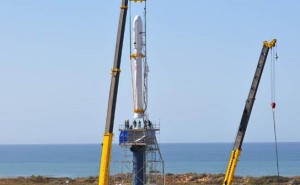NASA’s attempt to launch a carbon emissions-monitoring satellite into space has failed with the US$278 million Orbiting Carbon Observatory crashing into the Indian Ocean shortly after launch.

News wrap:
Washington Post: NASA Satellite Crashes Before Reaching Orbit
Reuters: Botched launch ends US satellite’s mission
The British Science Media Centre gathered comment from UK-based scientists on the implications of the loss of the satellite.
Dr Chris Welch, Principal Lecturer in Astronautics at Kingston University’s Faculty of Engineering, said:
“The Orbiting Carbon Observatory (OCO) was intended to measure carbon dioxide (CO2) in the Earth’s atmosphere. In particular, over time, it would have been able to build up a map of the Earth’s surface showing the relative levels of CO2. This would have helped us understand CO2 distribution and the effects of natural and human activities on it and its implications for global warming.
“All rockets have a fairing on the top of them to protect the payload. Once the rocket is high enough up, the fairing is jettisoned so that the payload can be deployed. At the moment, it looks as if the fairing did not separate and the increased mass meant that the satellite did not reach orbit and instead came back down to Earth near Antarctica.
“In terms of climate change science, the loss of OCO is an undoubted setback. It was going to become another element in a group of satellites called the Earth Observing System Afternoon Constellation (more commonly called the ‘A-train’. This would have allowed researchers to match the data from OCO with that from other instruments on other A-train satellites, particularly that from NASA’s Aqua satellite which would have followed 15 minutes behind it. Given its relatively low cost ($270 million), though, I would expect an OCO#2 to be approved. Fortunately, the Japanese GOSAT/Ibuki satellite was launched in January this year which has broadly similar aims: to map CO2 concentrations for better understanding the global carbon cycle and the factors that influence it.”
Professor John Burrows, director of the Biogeochemistry Programme at the UK Centre for Ecology & Hydrology and a co-investigator on the Orbiting Carbon Observatory (OCO) initiative (in his capacity as a member of the University of Bremen, Germany), said:
“The UK and European science community is a major partner in OCO and the loss of this instrument is a serious setback. The OCO mission aimed to make unique and high quality measurements of the atmospheric column of carbon dioxide at high spatial resolution. This information is urgently required to constrain our understanding of CO2 fluxes at the Earth’s surface (uptake by both the land surface and the oceans) and emissions from fossil fuel combustion.
“OCO planned to build on the first measurements by the European Sciamachy instrument on ENVISAT and is complementary to the recently launched Japanese mission, GOSAT.
“Detailed understanding of the surface emissions and uptake of CO2 is key to the accurate prediction of global climate change. We urgently need to invest in new European investment satellite based instruments to measure greenhouse gases from space as the first generation of such instruments, which have limited measurement capability, will stop operating by 2013.”
Dr Chris Huntingford, climate modeller at the UK Centre for Ecology & Hydrology, said:
“The failure of the OCO satellite is a major loss. The planned measurements from OCO would have helped refine our description of the carbon cycle in climate models, and thus allow more accurate predictions of future global warming.
“Climate models have improved tremendously over the last decade, and now include a complete description of the global carbon cycle. This includes capturing the effect of human burning of fossil fuels (which raises atmospheric carbon dioxide levels) and how the land and ocean currently buffer this by “drawing-down” carbon dioxide. However, there remains uncertainty in precisely how and where the land and ocean currently extract carbon dioxide from the atmosphere, and what magnitude these CO2-sinks will be for future climate change. OCO would have helped reduce this uncertainty.”
Prof Joanna Haigh, Professor of Atmospheric Physics at Imperial College London, said:
“At present, when we calculate the carbon input and output of our planet, the numbers don’t quite add up. In other words, there is some uncertainty about some of the major sources – and sinks – of carbon dioxide.
“This satellite would have helped remove that uncertainty. Its job was to measure the total amount of CO2 in a column between itself and the surface of the earth, which it would have done this several times a day at various positions all over the globe. Those measurements could then be used in computer models to deduce sources and sinks of CO2. It would also have helped us understand the variability in major carbon sinks such as rainforest, which vary in their CO2 absorption depending on the time of day.
“Among other things, the data could eventually have been used to monitor how well various regions were observing their international commitments on carbon emissions. The loss of this important satellite is a great disappointment and a setback to climate change science.”